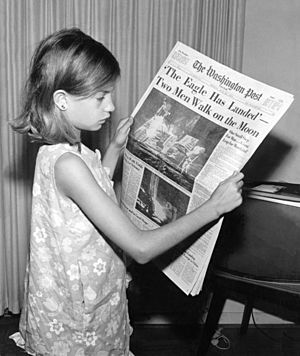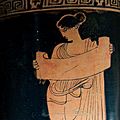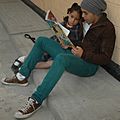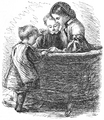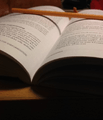Reading facts for kids
Reading is what we do when we understand writing.
More fully, it a cognitive process of understanding information represented by printed or written language. It is a way of getting information and insights about something that is written. Reading involves understanding the symbols in that language. It can only be done if one knows the language. Reading and hearing are the two most common ways to get information. Information gained from reading can include entertainment, especially when reading fiction or humor.
Proofreading is a kind of reading that is done to find mistakes in a piece of writing
Directed Reading-Thinking Activity is a method which aims to develop better reading.
- Making predictions/hypothesis about the content, idea, and concepts from the title of the reading material.
- Sectional reading or processing (chunking) of the material.
- Checking the reliability and similarity of the read content with the predictions supported by evidence from the text.
- For better comprehension, to know what and why the text says: review vocabulary, understanding of the main idea, syntax of the sentence, details/facts and sequence of the story, and make inferences about the characters’ attitudes, behaviors or circumstances in the story.
- Make plausible predictions about what the next section will be about in the reading material.
History of learning to read
The history of learning to read dates back to the invention of writing during the 4th millennium BC.
With respect to the English language in the United States, the phonics principle of teaching reading was first presented by John Hart in 1570, who suggested the teaching of reading should focus on the relationship between what is now referred to as graphemes (letters) and phonemes (sounds).
In the colonial times of the United States, reading material was not written specifically for children, so instruction material consisted primarily of the Bible and some patriotic essays. The most influential early textbook was The New England Primer, published in 1687. There was little consideration given to the best ways to teach reading or assess reading comprehension.
Phonics was a popular way to learn reading in the 1800s. William Holmes McGuffey (1800–1873), an American educator, author, and Presbyterian minister who had a lifelong interest in teaching children, compiled the first four of the McGuffey Readers in 1836.
The whole-word method was invented by Thomas Hopkins Gallaudet, the director of the American Asylum at Hartford. It was designed to educate deaf people by placing a word alongside a picture. In 1830, Gallaudet described his method of teaching children to recognize a total of 50 sight words written on cards. Horace Mann, the Secretary of the Board of Education of Massachusetts, U.S., favored the method for everyone, and by 1837 the method was adopted by the Boston Primary School Committee.
By 1844 the defects of the whole-word method became so apparent to Boston schoolmasters that they urged the Board to return to phonics. In 1929, Samuel Orton, a neuropathologist in Iowa, concluded that the cause of children's reading problems was the new sight method of reading. His findings were published in the February 1929 issue of the Journal of Educational Psychology in the article "The Sight Reading Method of Teaching Reading as a Source of Reading Disability".
The meaning-based curriculum came to dominate reading instruction by the second quarter of the 20th century. In the 1930s and 1940s, reading programs became very focused on comprehension and taught children to read whole words by sight. Phonics was taught as a last resort.
Edward William Dolch developed his list of sight words in 1936 by studying the most frequently occurring words in children's books of that era. Children are encouraged to memorize the words with the idea that it will help them read more fluently. Many teachers continue to use this list, although some researchers consider the theory of sight word reading to be a "myth". Researchers and literacy organizations suggest it would be more effective if students learned the words using a phonics approach.
In 1955, Rudolf Flesch published a book entitled Why Johnny Can't Read, a passionate argument in favor of teaching children to read using phonics, adding to the reading debate among educators, researchers, and parents.
Government-funded research on reading instruction in the United States and elsewhere began in the 1960s. In the 1970s and 1980s, researchers began publishing studies with evidence on the effectiveness of different instructional approaches. During this time, researchers at the National Institutes of Health (NIH) conducted studies that showed early reading acquisition depends on the understanding of the connection between sounds and letters (i.e. phonics). However, this appears to have had little effect on educational practices in public schools.
In the 1970s, the whole language method was introduced. This method de-emphasizes the teaching of phonics out of context (e.g. reading books), and is intended to help readers "guess" the right word. It teaches that guessing individual words should involve three systems (letter clues, meaning clues from context, and the syntactical structure of the sentence). It became the primary method of reading instruction in the 1980s and 1990s. However, it is falling out of favor. The neuroscientist Mark Seidenberg refers to it as a "theoretical zombie" because it persists in spite of a lack of supporting evidence. It is still widely practiced in related methods such as sight words, the three-cueing system and balanced literacy.
In the 1980s the three-cueing system (the searchlights model in England) emerged. According to a 2010 survey 75% of teachers in the United States teach the three-cueing system. It teaches children to guess a word by using "meaning cues" (semantic, syntactic and graphophonic). While the system does help students to "make better guesses", it does not help when the words become more sophisticated; and it reduces the amount of practice time available to learn essential decoding skills. Consequently, present-day researchers such as cognitive neuroscientists Mark Seidenberg and professor Timothy Shanahan do not support the theory. In England, synthetic phonics is intended to replace "the searchlights multi-cueing model".
In the 1990s Balanced literacy arose. It is a theory of teaching reading and writing that is not clearly defined. It may include elements such as word study and phonics mini-lessons, differentiated learning, cueing, leveled reading, shared reading, guided reading, independent reading and sight words. For some, balanced literacy strikes a balance between whole language and phonics. Others say balanced literacy in practice usually means the whole language approach to reading. According to a survey in 2010, 68% of K-2 teachers in the United States practice balanced literacy. Furthermore, only 52% of teachers included phonics in their definition of balanced literacy.
In 1996 the California Department of Education took an increased interest in using phonics in schools. And in 1997 the department called for grade one teaching in concepts about print, phonemic awareness, decoding and word recognition, and vocabulary and concept development.
By 1998 in the U.K. whole language instruction and the searchlights-model were still the norm, however there was some attention to teaching phonics in the early grades, as seen in the National Literacy Strategies.
Related pages
Images for kids
-
A reading muse
-
Volunteer reads to a girl at the Casa Hogar de las Niñas in Mexico City
-
Reading time at a primary school in rural Lao PDR, Southeast Asia. In 2017, approximately 70% of five-year-old children are not enrolled in Early Childhood Education programmes, with those in hard-to-reach areas and from poor families being the most excluded. The daily reading period shown here uses books provided by Big Brother Mouse, a not-for-profit that promotes reading in Lao schools and villages.
-
A Catholic monk reading in a monastery library
See also
 In Spanish: Lectura (educación) para niños
In Spanish: Lectura (educación) para niños



